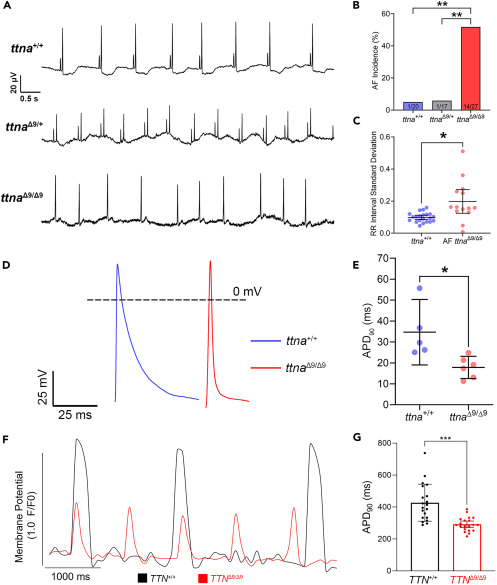Fig. 5 ttnaΔ9/Δ9 adult zebrafish exhibit atrial fibrillation (AF), and both ttnaΔ9/Δ9 zebrafish atrial cardiomyocytes and TTNΔ9/Δ9-hiPSC-aCMs demonstrate abnormal electrophysiology (A) Representative electrocardiogram (ECG) recordings of 7–15-months-old ttna+/+ (n = 20), ttnaΔ9/Δ9 (n = 17), and ttnaΔ9/Δ9 (n = 27) zebrafish hearts. Upper panel: ttna+/+ ECG trace; middle panel: ttnaΔ9/+ ECG trace; lower panel: ttnaΔ9/Δ9 ECG trace demonstrating P-wave loss and arrhythmia. (B) Quantification of AF incidence in ttna+/+, ttnaΔ9/+, and ttnaΔ9/Δ9 adult zebrafish. (C) Quantification of heartbeat interval standard deviation in zebrafish with AF in comparison to ttna+/+ adults. (D) Representative recordings of action potential (AP) on isolated ttna+/+ (n = 5) and ttnaΔ9/Δ9 (n = 6) zebrafish atrial cardiomyocytes at 12 months of age. (E) Quantification of AP duration at 90% repolarization (APD90) in isolated zebrafish atrial cardiomyocytes. (F) Representative optical AP recordings of TTN+/+-hiPSC-aCMs and TTNΔ9/Δ9-hiPSC-aCMs with voltage-sensitive dye VF2.1Cl. (G) Quantification of APD90 in hiPSC-aCMs (n = 4 independent batches, n = 5–6 biological replicates per batch). Data in (C, E, and G) are represented as mean ±95% confidence intervals. ∗p < 0.05; ∗∗p < 0.01; ∗∗∗p < 0.001. See also Figure S8 .
Image
Figure Caption
Acknowledgments
This image is the copyrighted work of the attributed author or publisher, and
ZFIN has permission only to display this image to its users.
Additional permissions should be obtained from the applicable author or publisher of the image.
Full text @ iScience

